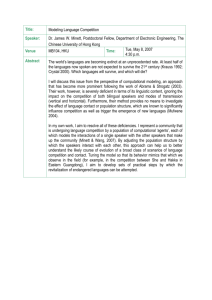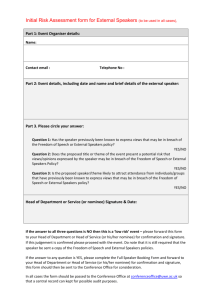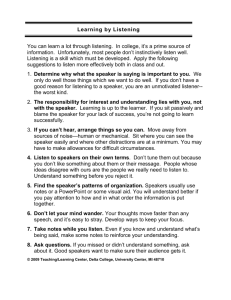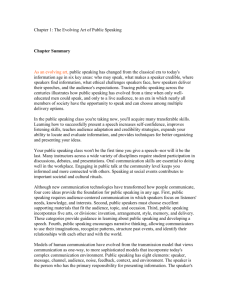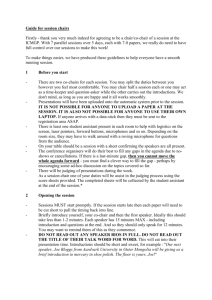speech presentation techniques
advertisement
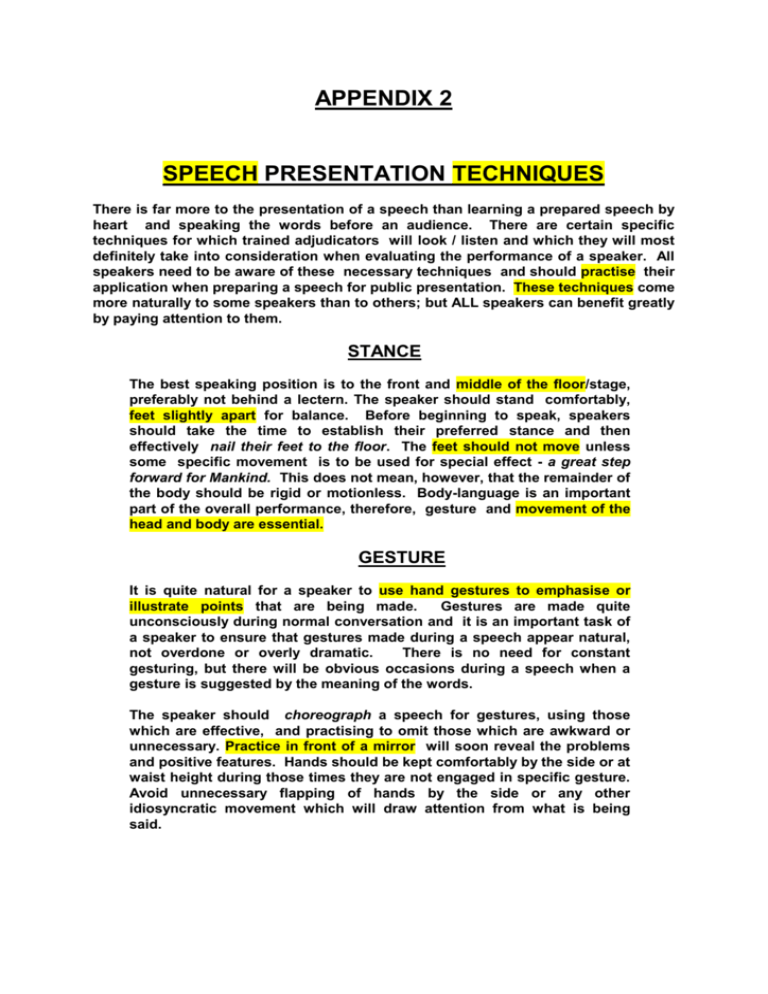
APPENDIX 2 SPEECH PRESENTATION TECHNIQUES There is far more to the presentation of a speech than learning a prepared speech by heart and speaking the words before an audience. There are certain specific techniques for which trained adjudicators will look / listen and which they will most definitely take into consideration when evaluating the performance of a speaker. All speakers need to be aware of these necessary techniques and should practise their application when preparing a speech for public presentation. These techniques come more naturally to some speakers than to others; but ALL speakers can benefit greatly by paying attention to them. STANCE The best speaking position is to the front and middle of the floor/stage, preferably not behind a lectern. The speaker should stand comfortably, feet slightly apart for balance. Before beginning to speak, speakers should take the time to establish their preferred stance and then effectively nail their feet to the floor. The feet should not move unless some specific movement is to be used for special effect - a great step forward for Mankind. This does not mean, however, that the remainder of the body should be rigid or motionless. Body-language is an important part of the overall performance, therefore, gesture and movement of the head and body are essential. GESTURE It is quite natural for a speaker to use hand gestures to emphasise or illustrate points that are being made. Gestures are made quite unconsciously during normal conversation and it is an important task of a speaker to ensure that gestures made during a speech appear natural, not overdone or overly dramatic. There is no need for constant gesturing, but there will be obvious occasions during a speech when a gesture is suggested by the meaning of the words. The speaker should choreograph a speech for gestures, using those which are effective, and practising to omit those which are awkward or unnecessary. Practice in front of a mirror will soon reveal the problems and positive features. Hands should be kept comfortably by the side or at waist height during those times they are not engaged in specific gesture. Avoid unnecessary flapping of hands by the side or any other idiosyncratic movement which will draw attention from what is being said. PALM CARDS Palm cards are acceptable, but seldom seen at the higher levels of competition. They need to be small, buff coloured and unobtrusive, and use must be very sparing. Use of palm cards should be honest with the cards overtly raised to a position that is convenient for reading. Any covert use of palm cards detracts from the performance. The use of palm cards does restrict the use of effective gesture and eye-contact, however, and a serious speaker should bear this in mind. EYE-CONTACT Members of an audience like to feel that they are being spoken to personally. This effect can be created by the speaker’s effective use of eye-contact and by the actual wording of the speech. Some speakers tend to focus their eyes on one spot for the duration of a speech. Others go to the opposite extreme and move their eyes from left to right, row by row, missing nobody out. The desirable technique is a happy medium between the two, where eye movement is not predictable but encompasses the entire audience in a seemingly random manner. (Make certain you do not forget to look at the most important members of the audience - the adjudicators!) FACIAL EXPRESSION Facial expression needs to be lively and reflective of the mood of the speech and the changing trends of the speech. Effective use of facial expression reinforces the message of a speech and contributes greatly to the audience impression of whether or not a speaker is genuine with regard to the treatment of the topic. This can only be achieved if the speaker is sufficiently familiar with the speech and has no need to look inward in the struggle to remember what comes next. VOCAL TONE Some speakers have been blessed with mellifluous vocal qualities. These are the ones who can capture audience attention and maintain it purely because their voices are extremely appealing. Speakers who are pleasant to hear generally tend to use the lower register of their voices, avoiding tones that are fine or shrill. They tend, also, to give their vowel sounds a slightly rounded quality. This can be done without going so far as to develop an unnatural elocutionary style. It is possible, with practice, to become accustomed to using the lower speaking register. The results can be well worth the effort. 2 PACING Public speaking is not an exercise in saying as much as possible in the allocated time. Some people speak far too quickly. The result is a lack of vocal clarity and a general failure to communicate meaningfully with the audience. A pace of 100 words a minute has proven to be most effective. For an 8 minute speech, a script of approximately 800 words is adequate. With appropriate emphasis and use of pause, the time limit of 8 minutes will be arrived at quite comfortably and the audience will be able to understand clearly the intended message. Pace needs to be varied to meet the demands of the speech. Light-hearted segments can be delivered more quickly; more serious content requires a more measured pace. PAUSE AND EMPHASIS These very necessary aspects of a speech presentation are often underrated or even ignored. Their correct use can improve a speech immeasurably, adding vitality, meaning and a sense of purpose. It is essential that a speaker study very carefully the final written form of a speech, saying each sentence out aloud and trying different stress patterns until the most effective one is established. A system of underlining or highlighting should be used to assist in the practising of the speech. Ironically, one of the most effective qualities of a speech is the use of SILENCE in the form of pauses at appropriate places for the purpose of drawing attention to specific words/phrases and allowing the audience time to assimilate what has just been said. Care must be taken to ensure that the written form of a speech is effectively punctuated. Pause and vocal inflection are necessary to translate those punctuation marks into the spoken form of communication. A speaker needs to allow a reasonable pause at the end of a “paragraph”, firstly, to signify a change / progression in content and, secondly, to allow time for thinking ahead to the opening words of the next paragraph. Pause can be indicated on the written script and rehearsed along with emphasis. Example : Even here, in Australia, the lucky country, we expect Nature to provide for us.........and she does.....but she can provide only so much! Note: Paragraphing a speech is somewhat different from paragraphing an essay. Initially, paragraph as for an essay, then split long paragraphs into shorter paragraphs at strategic positions. This aids in the learning process and assists with size of palm cards for the initial learning stage. 3 VARIATION Variation can add a great deal of spice to one’s life - and it can do the same thing for a speech. VARIATION needs to become an underlying theme throughout all aspects of speech preparation. Avoid unnecessary repetition of words and phrases. Avoid repetitive gestures. Use eyecontact in a seemingly random manner. Use vocal variation with respect to volume, pace, and tone in an effort to create a sense of light and shade - soft and loud, fast and slow, higher and lower registers. Ensure that quotations stand out from the rest of the “text” by delivering them in an altered tone, perhaps at a slower pace. TIMING Timing causes a great deal of concern for most speakers. In some competitions, accurate timing is a quite crucial issue. In others, there is a thirty second allowance before and after the allocated time. As suggested above, a rate of 100 words per minute allows time for gesture, pause and emphasis. Additional time should be allowed for laughter in a humorous speech. Speakers can also consider the safeguard of a sentence or two which can either be inserted or left out once the warning bell (or absence of the warning bell) indicates a timing problem. The conclusion should be timed to fit between the warning bell and the final bell. Speakers should prepare the conclusion particularly well and should avoid changing it in any way at the time of actual presentation. ADDRESSING THE CHAIRPERSON The Chairperson and the audience should be addressed at the very start of the speech (Mr Chairman / Madam Chairman, Ladies and Gentlemen). The audience should also be addressed just prior to the opening words of the Conclusion (Ladies and Gentlemen). Avoid the use of these terms at any other time. The initial address should precede ALL parts of the speech. Some speakers like to make a dramatic beginning and then address the Chairperson and audience. This often breaks into the continuity and mood of the speech and it is not recommended. 4 PALM CARDS for final presentation should be no more than 9 cm X 5 cm. They should be written / printed on one side only. THEY MUST BE NUMBERED CLEARLY. The entire speech should be memorised. For the final presentation, the speaker should only have KEY words on the palm cards not sentences. DO NOT READ SENTENCES FROM YOUR PALM CARDS ! 5

